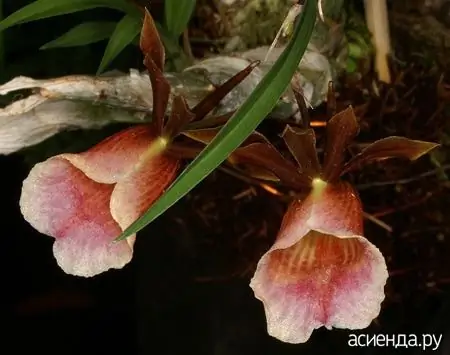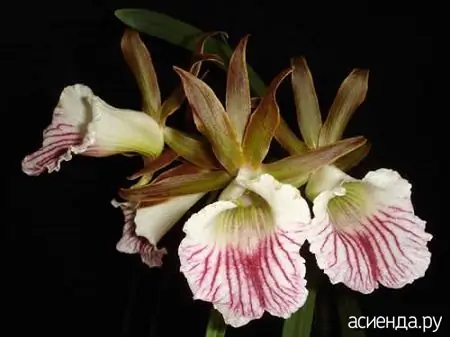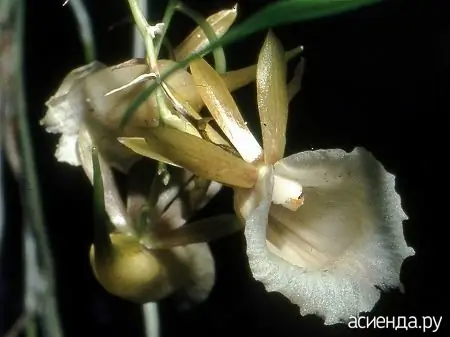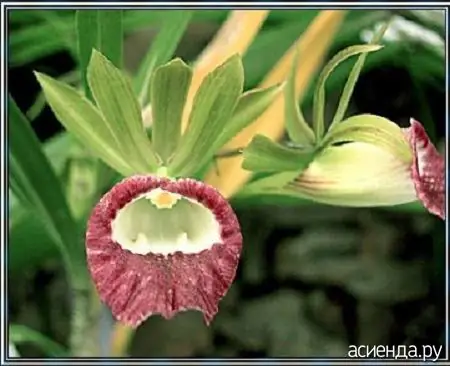Искусственные гибриды (грексы) с участием представителей рода Galeandra
По данным The International Orchid Register.
- Catasandra Jem’s Imperial Gal — Gal. batemanii x Ctsm. pileatum, G.Monnier, 2003
- Galeodes Freckles — Gal. devoniana x Morm. sinuata, Mrs R.Levy, 2002
- Galeandra Lauren Michelle Moses — Gal. baueri x Gal. leptoceras, J.Stubbings, 2008
- Galeandra Karen Lewis — Gal. devoniana x Gal. claesii, J.Stubbings, 2007
- Galeandra Sarah Moses — Gal. Sandy Stubbings x Gal. devoniana, J.Stubbings, 2006
- Galeandra Kelly Stubbings — Gal. dives x Gal. leptoceras, Clown Alley Orch., 2006
- Galeandra Clownalley Center Ring — Gal. Beth Stubbings x Gal. Gary Chanson, J.Stubbings, 2000
- Galeandra Clownalley Straightup — Gal. Sandy Stubbings x Gal. dives, J.Stubbings, 2000
Cultural use
Beautiful inflorescences of plants of the genus, distinguished by flowers with a spectacular tubular lip and a variety of colors of flower petals, have made many species of the genus Galeander popular greenhouse and indoor plants.
Due to the fact that in the wild, different species live in different climatic conditions, you can always choose a species for any temperature zone — from warm to cold.
For growing orchids of the genus Galeander, different types of planting are suitable. These can be special baskets for epiphytic plants; ceramic or plastic pots filled with a well-drained mixture, since moisture stagnation is destructive for most orchid species; or landing on the block.
Beautifully flowering species of the genus are used to create hybrids, of which there are already a great many.
Protecting orchids from poaching and threats of extinction
People tend to use the beauty of the plant world for their own interests, which are not always consistent with the consequences of the barbaric destruction of rare plant species that are gradually disappearing from the face of the planet.
People who are not indifferent to the future of the plant world of the Earth are trying to reach out to the consciousness of people, establishing restrictions and rules that should be guided by those who are involved in the trade in wild plants.
Охрана исчезающих видов
Galeandra minax
Все виды рода Galeandra входят в Приложение II Конвенции CITES. Цель Конвенции состоит в том, чтобы гарантировать, что международная торговля дикими животными и растениями не создаёт угрозы их выживанию.
Приложение включает все виды, которые в данное время хотя и не обязательно находятся под угрозой исчезновения, но могут оказаться под такой угрозой, если торговля образцами таких видов не будет строго регулироваться в целях недопущения такого использования, которое несовместимо с их выживанием; а также другие виды, которые должны подлежать регулированию для того, чтобы над торговлей образцами некоторых видов из первого списка мог быть установлен эффективный контроль.
Varieties
The number of species in the genus, like in most plants of the Orchid family, is a variable, due to the large number and diversity of the representatives of the family, which have not yet been sufficiently studied by botanists. With a more meticulous study of botany, then one genus is divided into several, then some of the species are transferred from one genus to another. Today, about 40 plant species are in the described genus.
The most famous types are:
* Galeandra baueri
 Image
Image
* Galeandra batemanii
* Galeandra devoniana
 Image
Image
* Galeandra stangeana
* Galeandra lacustris
 Image
Image
* Galeandra dives
* Galeandra minax
 Image
Image
Related Research Articles
The bar-tailed godwit is a large wader in the family Scolopacidae, which feeds on bristle-worms and shellfish on coastal mudflats and estuaries. It has distinctive red breeding plumage, long legs, and a long upturned bill. Bar-tailed godwits breed on Arctic coasts and tundra from Scandinavia to Alaska, and overwinter on coasts in temperate and tropical regions of the Old World, Australia and New Zealand. The migration of the subspecies Limosa lapponica baueri across the Pacific Ocean from Alaska to New Zealand is the longest known non-stop flight of any bird, and also the longest journey without pausing to feed by any animal. The round-trip migration for this subspecies is over 29,000 km (18,020 mi).
Banksia baueri, commonly known as the woolly banksia, is a species of shrub that is endemic to the southwest of Western Australia. It has serrated leaves and a distinctively large and hairy looking inflorescence with cream, yellow or brown flowers, and hairy fruit.
Banksia sect. Banksia is one of four sections of Banksia subgenus Banksia. It contains those species of subgenus Banksia with straight or sometimes curved but not hooked styles. These species all have cylindrical inflorescences and usually exhibit a bottom-up sequence of flower anthesis. It is a widely distributed section, with taxa occurring in both the south west and east coastal distributions of the genus.
Banksia ser. Quercinae is a valid botanic name for a series of Banksia. First published by Carl Meissner in 1856, the name has had three circumscriptions.
Rhopalostylis baueri is a species of palm native to Norfolk Island (Australia) and to the Kermadec Islands. Norfolk Island is the type locality. The common names on Norfolk Island are ‘Norfolk Island palm’ or ‘niau’. In New Zealand the name ‘Kermadec nikau’ is used to refer to the Kermadec Islands population.
Grevillea baueri, commonly known as Bauer’s grevillea, is a low-growing shrub which is endemic to the coastal ranges of south-eastern New South Wales in Australia. It usually grows up to 1 metre in height and 2 metres in width. Flowers are produced in late winter and spring. These have a red perianth with a cream tip and a green-tipped red style.
Galeandra, abbreviated as Gal in horticultural trade, is a genus of 37 known species of orchids native to South America, Central America, the West Indies and Florida.
Galeandra nivalis is a species of orchid endemic to northern Brazil.
Catasetinae is a subtribe within the Orchidaceae and contains 8 genera. Its members are widespread in lowland tropical Central and South America up to 1,500 meters. They are found on trees, stumps or old fence posts.
Eulophia gracilis is a species of orchid, occurring from Western Tropical Africa to Angola.
Galeandra batemanii is a species of orchid native to Oaxaca and Central America.
Galeandra minax is a species of orchid native to Brazil and Venezuela.
Galeandra styllomisantha is a species of orchid. It is widespread across much of South America from Guyana to Argentina.
Oncidium baueri is a species of orchid native to Costa Rica and to South America as far south as Bolivia and Brazil.
Hemnypia is a monotypic moth genus in the family Geometridae. Its only species, Hemnypia baueri, is found in the US state of California. Both the genus and the species were first described by James Halliday McDunnough in 1941.
Galeandra bicarinata is a species of orchid native to Cuba and Florida. It is closely related to G. beyrichii and regarded as part of that taxon until described as a distinct species in 2000.
Agathymus baueri, or Bauer’s giant-skipper, is a species of giant skipper in the family Hesperiidae. It is found in North America.
Egira baueri is a species of cutworm or dart moth in the family Noctuidae. It is found in North America.
Abagrotis baueri is a species of cutworm or dart moth in the family Noctuidae. It is found in North America.
Chara baueri is a species of alga belonging to the family Characeae.
Искусственные гибриды (грексы) с участием представителей рода Galeandra
По данным The International Orchid Register.
- Catasandra Jem’s Imperial Gal — Gal. batemanii x Ctsm. pileatum, G.Monnier, 2003
- Galeodes Freckles — Gal. devoniana x Morm. sinuata, Mrs R.Levy, 2002
- Galeandra Lauren Michelle Moses — Gal. baueri x Gal. leptoceras, J.Stubbings, 2008
- Galeandra Karen Lewis — Gal. devoniana x Gal. claesii, J.Stubbings, 2007
- Galeandra Sarah Moses — Gal. Sandy Stubbings x Gal. devoniana, J.Stubbings, 2006
- Galeandra Kelly Stubbings — Gal. dives x Gal. leptoceras, Clown Alley Orch., 2006
- Galeandra Clownalley Center Ring — Gal. Beth Stubbings x Gal. Gary Chanson, J.Stubbings, 2000
- Galeandra Clownalley Straightup — Gal. Sandy Stubbings x Gal. dives, J.Stubbings, 2000
What’s in your name
In the Latin name of the genus «Galeandra» there are two words: the Latin word «galea» meaning «helmet» and the Greek word «andros» meaning «male.» The reason for this name was the shape of the anther cap, similar to the helmet of an ancient warrior.
The genus «Galeandra» was proposed in 1830 by the English botanist John Lindley (1799-02-05 — 1865-11-01).
The type species of the genus is the plant «Galeandra baueri».
The Latin name of the genus has synonyms, including the following — “
Corydandra ».
In the literature on floriculture, the name of the genus uses an abbreviation of three letters — “
Gal ».
Виды.
Galeandra stangeana
Galeandra lacustris
Galeandra dives
Galeandra baueri
Galeandra batemanii
Виды (включая устаревшие названия) приводятся по данным Королевских ботанических садов в Кью:
- Galeandra andamanensis Rolfe, 1895
- Galeandra angornensis Rchb.f., 1847
- Galeandra angornensis Rchb.f. in W.G.Walpers, 1863
- Galeandra arundinis Garay & G.A.Romero, 2005
- Galeandra badia Garay & G.A.Romero, 1998
- Galeandra barbata Lem., 1856
- Galeandra batemanii Rolfe, 1892
- Galeandra baueri Lindl. in F.A.Bauer, 1830 typus
- Galeandra baueri var. pilosocolumna C.Schweinf., 1944
- Galeandra beyrichii Rchb.f., 1850
- Galeandra bicarinata G.A.Romero & P.M.Br., 2000
- Galeandra biloba Garay, 1999
- Galeandra bouliawongo Rchb.f., 1852
- Galeandra camptoceras Schltr., 1910
- Galeandra carnevaliana G.A.Romero & Warford, 1995
- Galeandra chapadensis Campacci, 2001
- Galeandra claesii Cogn., 1893
- Galeandra coxipoensis Hoehne, 1912
- Galeandra cristata Lindl., 1844
- Galeandra curvifolia Barb.Rodr., 1877
- Galeandra descagnolleana Rchb.f., 1887
- Galeandra devoniana M.R.Schomb. ex Lindl., 1840
- Galeandra dives Rchb.f. & Warsz., 1854
- Galeandra duidensis Garay & G.A.Romero, 1998
- Galeandra euglossa Rchb.f., 1852
- Galeandra extinctoria Lindl., 1833
- Galeandra fiebrigii Schltr., 1922
- Galeandra flaveola Rchb.f., 1887
- Galeandra funckiana Lindl. ex Rchb.f., 1881
- Galeandra funckii Lindl. ex Rchb.f., 1856
- Galeandra gracilis (Lindl.) Lindl., 1833
- Galeandra graminoides Barb.Rodr., 1877
- Galeandra greenwoodiana Warford, 1994
- Galeandra harveyana Rchb.f., 1883
- Galeandra huebneri Schltr., 1925
- Galeandra hysterantha Barb.Rodr., 1877
- Galeandra juncea Lindl., 1840
- Galeandra junceoides Barb.Rodr., 1877
- Galeandra lacustris Barb.Rodr., 1877
- Galeandra lagoensis Rchb.f. & Warm. in H.G.Reichenbach, 1881
- Galeandra leptoceras Schltr., 1920
- Galeandra levyae Garay, 1999
- Galeandra longibracteata Lindl., 1862
- Galeandra macroplectra G.A.Romero & Warford, 1995
- Galeandra magnicolumna G.A.Romero & Warford, 1995
- Galeandra minax Rchb.f., 1874
- Galeandra montana Barb.Rodr., 1881
- Galeandra multifoliata W.Zimm., 1934
- Galeandra nivalis Mast., 1882
- Galeandra paraguayensis Cogn., 1903
- Galeandra paranaensis Schltr., 1920
- Galeandra petersii Rchb.f., 1847
- Galeandra pilosocolumna (C.Schweinf.) D.E.Benn. & Christenson, 2001
- Galeandra pubicentrum C.Schweinf., 1943
- Galeandra quartiniana (A.Rich.) Rchb.f. in W.G.Walpers, 1852
- Galeandra santarena S.H.N.Monteiro & J.B.F.Silva, 2003
- Galeandra stangeana Rchb.f., 1856
- Galeandra styllomisantha (Vell.) Hoehne, 1952
- Galeandra villosa Barb.Rodr., 1877
- Galeandra viridis Barb.Rodr., 1881
- Galeandra xerophila Hoehne, 1915
Литература
- Ежек Зденек, Орхидеи. Иллюстрированная Энциклопедия. Издательство: Лабиринт, 2005 г. ISBN 5-9287-1134-4
- Monteiro SHN, da Silva JBF, 2004, Notas sobre o genero Galeandra Lindl. Orquidario 18. (1): 5-9
- Garay LA, 1999, Orchid species currently in cultivation. Harvard Pap. Bot. 4. (1): 301-319
- Romero GA, Warford N, 1995, Three new Galeandra (Orchidaceae: Cyrtopodiinae) species from the Venezuelan Guayana. Lindleyana 10. (2): 75-91
- Warford N, 1994, The Mexican Galeandras (Orchidaceae). Lindleyana 9. (1): 39-49
- LeDoux MM, 1993, Galeandras. Orchid Dig. 57. (3): 124-127
- Jouy A, 1990, Sur quelques orchidees de la foret Bresilienne. Orchidophile 21. (93): 163-166
- Siegerist ES, 1983, Galeandra: a case of taxonomic confusion. Amer. Orchid Soc. Bull. 52. (2): 159-162
- Klaassen A, 1979, Het geslacht Galeandra Ldl. Orchideeen 41. (2): 64 — 66
- Sheehan T, Sheehan M, 1978, Orchid genera, illustrated: 64. Galeandra. Amer. Orchid Soc. Bull. 47. (9): 796 — 797
- Dunsterville GCK, Dunsterville E, 1975, Venezuelan Galeandra species. Orchid Rev. 83. (983): 161-165
- Teuscher H, 1975, Collector’s item: the genus Galeandra: G.devoniana, G.lacustris and G.dives. Amer. Orchid Soc. Bull. 44. (5): 395-400
- Teuscher H, 1975, Die Gattung Galeandra: G.devoniana, G.lacustris, G.dives. Orchidee 26. (1): 1-5
- Pollard GE, 1974, El genero Galeandra en Mexico. (The genus Galeandra in Mexico). Orquidea (Mexico) 4. (6): 163-171
Description
Most species of the genus Galeander are epiphytic plants that live on trees that grow at low altitudes (up to 500 meters above sea level). Species growing at high altitudes are either lithophytes or terrestrial creatures.
Plants of the genus Galeander are of the sympodial type of growth, growing from small to medium size. A characteristic feature of the genus are elongated, cylindrical or spindle-shaped pseudobulbs, from the nodes of which thin and narrow leaves are born.
From the top of the pseudobulb, a peduncle appears into the world, bearing a racemose inflorescence formed by a different number of flowers, from a few pieces to a multi-flowered creature. Most species exhibit very showy flowers of all colors with tubular lips and a well-defined spur.




